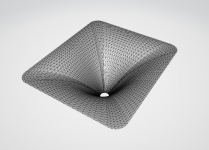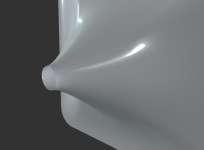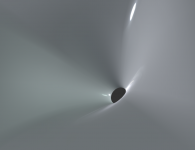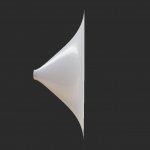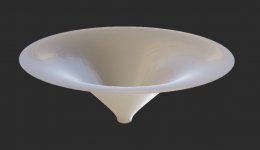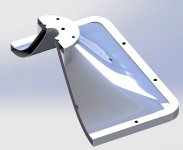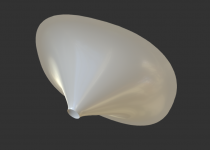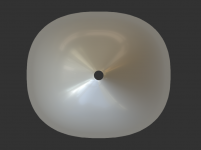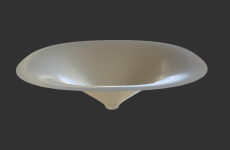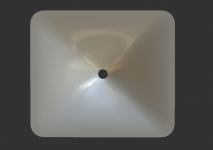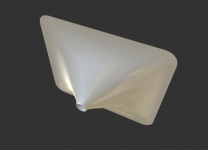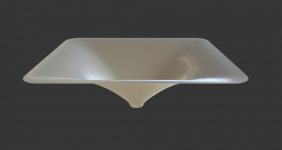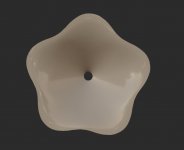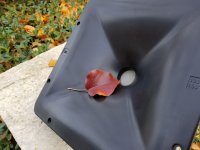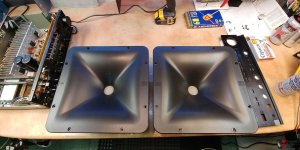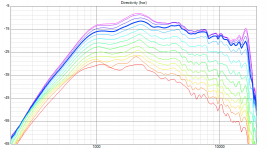We are trying find solution how to make waveguide with minimum set of points and should be ready till Monday.
Fabulous - can’t wait to see how it turns out! 🙂
Of course "the pure" OS could still be made. With a large roundover at the mouth (here also via a clothoid) the axial ripple is not there anymore. Tested with ABEC. It only gets big quite quickly.
Attachments
Last edited:
Nack/Marcel,
Ingenious! What would be the specs of each of those (differences) provided you’d scale them as large as you possibly can on the 3D printer on-hand?
Ingenious! What would be the specs of each of those (differences) provided you’d scale them as large as you possibly can on the 3D printer on-hand?
Would a jmlc profile with a 20 degrees include angel at the throat have a wider dispersion than the normal profiles (which often is made with a t=0.8, which I have been told is ca 13ish degrees include angle/6.5 degrees exit angle)?
InOtIn,
here are the basic STLs that would fit into Jacek's machine, you can look.
(online STL viewer: Free online STL viewer)
here are the basic STLs that would fit into Jacek's machine, you can look.
(online STL viewer: Free online STL viewer)
Attachments
Of course "the pure" OS could still be made. With a large roundover at the mouth (here also via a clothoid) the axial ripple is not there anymore. Tested with ABEC. It only gets big quite quickly.
Finally a real waveguide. I would expect it's performance to be exemplary.
Hi Earl,Finally a real waveguide. I would expect it's performance to be exemplary.
I would expect both of them to perform very well.
Maybe some slight disruption of the output symmetry may be even better, I don't know (superellipse instead of a circle) -
Attachments
Rosey 🙂
What you need to do now is take one of the rectangular ones, say 90 x 60, scale it up to 80-100 cm wide, and make ports and adapter plates on the sides for a couple of suitable woofers, to make it a two-way synergy.
What you need to do now is take one of the rectangular ones, say 90 x 60, scale it up to 80-100 cm wide, and make ports and adapter plates on the sides for a couple of suitable woofers, to make it a two-way synergy.

Hi Earl,
I would expect both of them to perform very well.
Maybe some slight disruption of the output symmetry may be even better, I don't know (superellipse instead of a circle) -
My experience is that more symmetry is better. The best waveguide that I have ever measured is purely axisymmetric.
Smaller waveguides have issues related to their size and sometimes non-symmetry can help, but in a bigger waveguide this is never going to be the case. Bigger is always best.
The square one looks similar to newest jbl pt square waveguide.
Attachments
Last edited:
I have to admit that based on the simulations I have made so far it seems you are completely right. The size is really the key and when made big enough, the OS waveguide may be hard to beat. You have been saying this all the time and now I really know what you meant. With smaller ones, it is possible to do better. That is what we are trying here.My experience is that more symmetry is better. The best waveguide that I have ever measured is purely axisymmetric.
Smaller waveguides have issues related to their size and sometimes non-symmetry can help, but in a bigger waveguide this is never going to be the case. Bigger is always best.
Last edited:
I have to admit that based on the simulations I have made so far it seems you are completely right.
I'm glad that we can agree.
I started out doing more optimal designs and kept try to push that smaller, but I always found that smaler was always seriously compromised. There is an optimum for any size however, but I never found that non-symmetric gave me any advantages.
For example, this slightly non-axisymmetric horn has dimensions of 14.7" x 13.8" (DE250). I made OS waveguides of this size before and none of them behaved so well. It may be that I gave up too early - the termination is really critical which I have realized only recently. Do you think you could design OS WG of this size to perform better?
Attachments
Last edited:
- Home
- Loudspeakers
- Multi-Way
- 1.4" or 2" throat large constant directivity horns you can actually buy!
